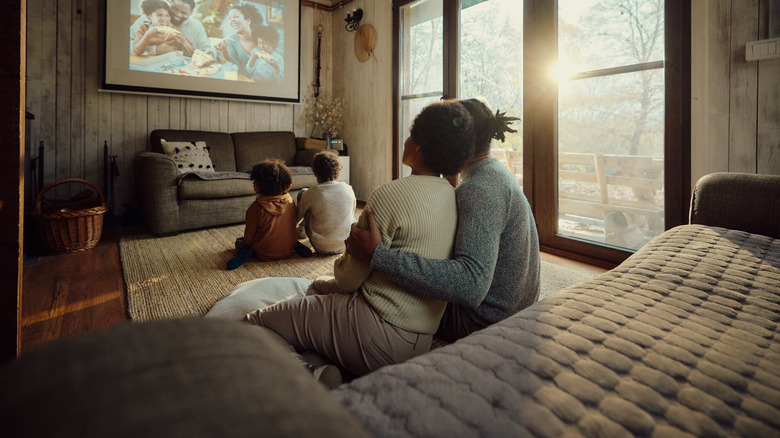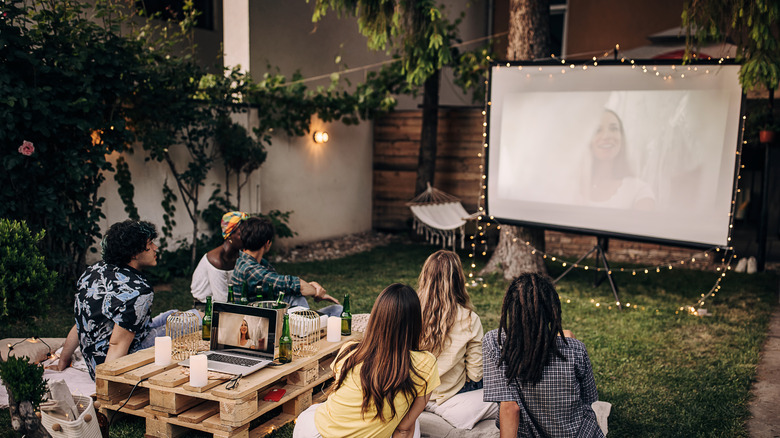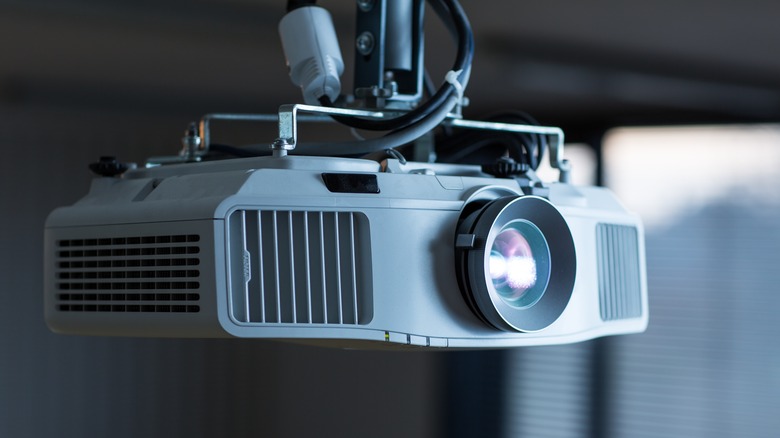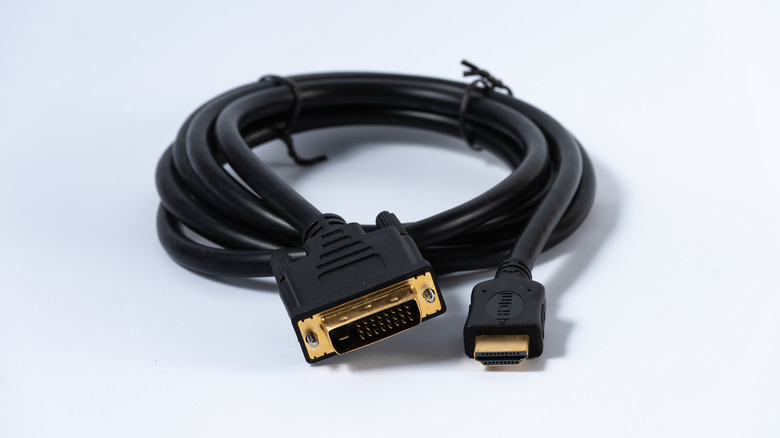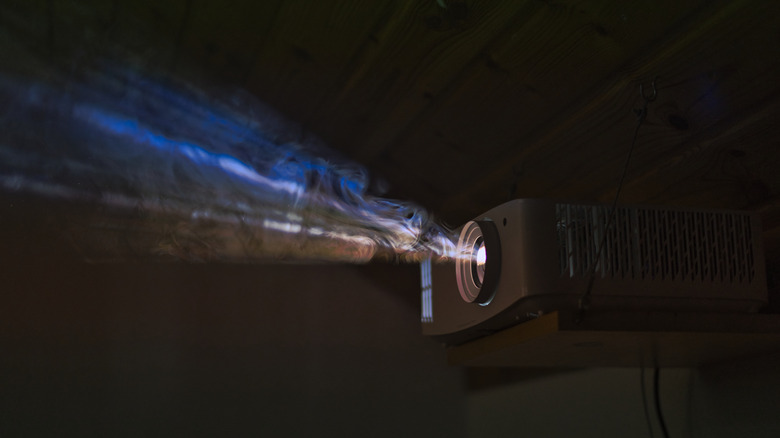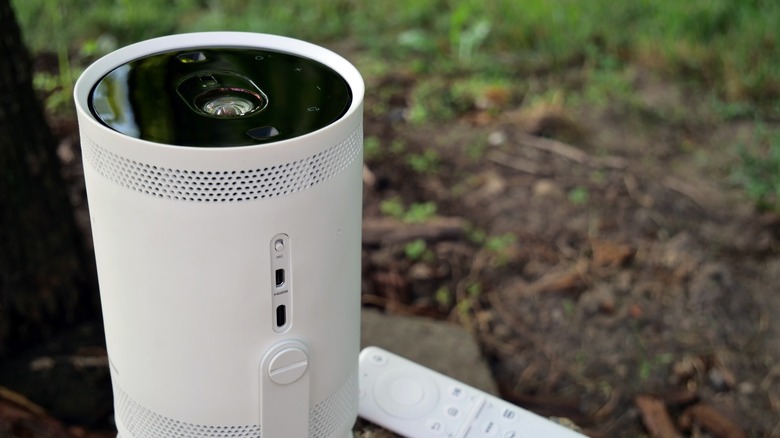6 Ways To Keep Your Projector's Image Looking Bright And Sharp
We may receive a commission on purchases made from links.
Whether it's to prepare for a game night with your friends, a movie night with the love of your life, or even setting up for an important meeting, a projector can be the perfect addition to your home, office, or even events venue. While there are plenty of cheap TVs in the market, there are a couple of reasons why you may still want to opt for a projector instead.
For example, projectors can be relatively easier to put away when not in use, so they're perfect for RVs, smaller homes that don't necessarily have space for a TV, or when your planned living room's aesthetic just doesn't match. In addition, it's much cheaper to get a larger screen size with projectors, which can be comparatively more expensive for similar-sized TV units. Not to mention, projectors are a great way to be able to display things outdoors with minimal set-up, especially for temporary events like dates or parties.
However, anyone who has ever tried to use a projector will tell you that they don't always cooperate when you need them. In some cases, projectors can look blurry, dull, or fuzzy, which can lead to annoying viewing experiences for everyone involved. Thankfully, whether you're a seasoned projector owner or someone who just desperately needs it to work at your next big presentation, you can do a few things to keep your images bright and sharp.
Adjust your ambient lighting
In general, projectors work best in darker environments, which means you need to adjust the lighting to make your images look clearer and sharper. If your projector is placed indoors, you can invest in things like curtains, blinds, or blackout shades to dim the room when necessary. Aside from this, you can also create more contrast by turning off any lamps, ceiling lights, or wall lights.
On the other hand, if you plan to use it outside during the day, it's recommended to place your projector away from direct sunlight. While you're at it, you may want to consider how much exposure your projector will have in terms of temperature fluctuation. Similar to your computer, keeping it in a shaded area and at moderate room temperature can prevent it from overheating and causing unnecessary internal damage.
At night, it's best to turn off any nearby light sources as well, such as neighboring buildings or outdoor lights. However, you'll need to be mindful of ventilation, so make sure your projector is placed on a solid surface and not fabric, which can constrict the airflow.
Invest in a projection screen
Unlike TVs, where the viewing angle is fixed, projectors can be a bit more complex, especially if you're looking to use a screen. Although it is possible to use walls, investing in a proper projection screen can remove a lot of potential issues related to reflectivity. Screens offer a uniform surface, which means you can avoid any image distortions from things in the background, such as uneven wall textures or distracting wallpaper. In addition, some screens will use material such as vinyl or other special coatings, which can improve picture qualities, such as contrast.
Typically, projectors are either placed on a mount from the ceiling or on a nearby table. If you're not sure how far back you can place your projector from your screen, you can check its manufacturer's website or manual for an optimal distance recommendation. Often, adjusting your projector screen will take a bit of trial and error, especially if it's not mounted in a permanent location.
If you're not sure how to do your setup properly and need to use your projector in a professional setting, you should consider hiring a professional installer. Aside from being able to help you find the best place to mount it, they'll be able to give you guidelines on how to set it up for your needs. Lastly, depending on your municipality, there might be specific building codes if you're planning to run your cables through your walls.
Check your lamp and filters
In general, projectors use built-in reflectors called lamps to concentrate light in a specific direction. Similar to other lights, projector lamps will slowly start to dim and display less crisp images with time. According to Epson, projector lamps typically last for about 3,000 hours in low-brightness mode and up to 2,000 hours when used consistently in high-brightness mode.
For some Epson projectors, it's possible to check how long you've used a certain lamp by going to its menu and selecting About > Lamp. The total number of hours it has been used so far will be displayed on the right side. Once you have replaced your lamp, you can opt to reset the lamp timer so you can have a more accurate view of when the next to replace it.
Alternatively, to know if your projector lamp is due for a replacement, you can also just observe it during use. If a lamp is starting to deteriorate, you'll notice that the images displayed will appear comparatively darker each time. Some projector models may even show a notification or warning lights when the lamp needs replacement.
Aside from lamps, you should also regularly inspect your projector's filters. Vivitek recommends cleaning your projector's fans every 500 hours of operation to prevent dust and other particles from building up. Similar to its lamp, some models of projectors will also display a warning if your fans are due for a cleaning.
Use high-quality HDMI cables
When connecting a laptop to the projector, you'll need to use a High-Definition Multimedia Interface (HDMI) cable. In some cases, a faulty HDMI cable could be the reason your projector's image isn't as crisp as you'd hoped. An HDMI cable may not work if it has bent input pins and exposed cord wires. Often, this can be attributed to bending the cable irregularly or improper storage. Aside from poor image quality, audio issues like static noises or issues with controls can also signal HDMI cable issues.
Not to mention, many people don't realize that there is more than one type of HDMI cable. Although many of the newer models are still compatible with older systems, the latest HDMI 2.1 cables offer a variety of other benefits, such as support for higher frame rates, faster data speeds, and improved audio. In 2022, there was even an HDMI 2.1a release, which added an incremental update with the Source-Based Tone Mapping feature, which is essential for people using high dynamic range (HDR) displays. Although HDR is a standard for many TV displays, which doesn't necessarily apply to projectors, you may still get more bang for your buck by having it as an option.
In many ways, investing in a high-quality HDMI cable is worth the money, especially because you don't have to use it exclusively for your projector. Aside from your projector, you can use your HDMI cables when connecting your laptop to your monitor or television set.
Calibrate your projector
With projectors having multiple uses, you may need to adjust your settings based on the situation. Depending on your model and manufacturer, it will also have specific recommendations for you to get the best viewing experience.
For example, Samsung recommends a variety of tricks to improve its calibration, such as adjusting picture quality. In this setting, you can choose between Dynamic, Standard, Movie, and Filmmaker Mode. While some modes can be more suitable for watching movies in a dark room, others employ more advanced options, like disabling features like motion smoothing and color enhancements, so you can enjoy movies exactly how directors envisioned them. Aside from this, you can also set viewing experiences designed for external devices, such as game mode, for people using consoles like PS5 and Xbox Series X|S.
While different projectors will need different settings, there are some universal ones, such as dial-in focus. However, some projector models have now introduced autofocus features that are great for tech-challenged households. For manual focus, you need to slowly turn the dial until you can see the pixels as intended on the screen, which can depend on the resolution of your projector. In some low-cost projectors, you may also encounter inconsistent quality, such as halos around letters or parts of the screen being out of focus.
If you're hoping for a theater-like experience on your projector, you may need to manually adjust settings like contrast, sharpness, and color tone to fit the mood of the movie or show you would like to watch.
Update your projector software
Similar to many other electronics, you can definitely benefit from updating your projector's software. Aside from addressing known security issues, your manufacturer may issue software updates to optimize your projector's usage, introduce new features, or improve the quality of the display. Although no frequency is set in stone, it's best to check regularly if your projector is due for an update, especially if you've owned your projector for years.
For people who own a Samsung Freestyle Projector, you can update it directly on your device. Using either your smartphone or remote control, you can connect your Freestyle Projector to a Wi-Fi signal and go to the Support > Software Update section. If your projector is not using the latest version of the software, you'll be able to see the option to select Update Now. Afterward, you can even enable the update process to happen automatically moving forward.
In some cases, such as with select Epson projectors, you may need to use a USB storage device. First, you'll need to download the specific firmware file for your projector model from its designated support website. Then, you'll need to move this file into the root folder of a USB device. Next, plug the USB into your projector and navigate to its Settings menu, wherein you can manually start the update process.
